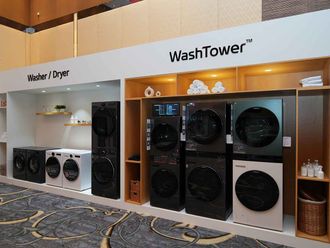Across the Middle East, there is a quiet revolution of bars and restaurants that are designed with locality and context at the forefront.
Over the past two decades, our region has invited some of the biggest names in design to author our nightlife experience, but that is beginning to change. A maturity in the region’s appetite for quality design reflects in a new generation of home-grown design talent, but more importantly, it manifests in top-notch F&B venues — that flirt with the local context to deliver stellar concepts that buoy local businesses — designed by regional designers.
Anarchitect in Sharjah
What was half a century ago a grocery store and a clinic, is now a five-room boutique hotel in the Sharjah desert. The low-lying structure appears humble against the foothills of Mount Alvaah, but is replete with rich, contextual detailing courtesy Jonathan Ashmore of the Dubai and London based studio Anarchitect. The discarded complex is now clad in rust coloured weathered steel that echoes the rich deposits of iron ore in the area and salutes the lodge’s sun-beaten location. Using locally sourced concrete and stone alongside polished concrete, granite, travertine and hardwood, the resort blends with the site while still standing out for it remarkably contemporary stance. If a saltwater spa and open air swimming pool were not enough, each room comes with its own stargazing skylight. With its strong volumetric and visual language, the lodge contradicts and blends with its landscape, all at once.
T.ZED Architects in Kuwait
For Ora — a Japanese tapas restaurant, its interiors explore the origins of the cuisine in the context of Kuwaiti traditions. Dubai-based T.ZED Architects played with traditional Japanese joinery techniques in an earthy setting, deploying a palette of warm colours and natural materials to delivery contemporary Zen. Be it the lightwood flooring, tan leather seating, the choice of artwork or dark slatted ceilings that masterfully contradicts a rather flightful installation of indigo-ed Japanese fans and perfectly round mirrors, the designer tips his hat to Japanese design codes throughout the venue. It is in the spatial design — with regard to privacy and flexibility to accommodate diverse group sizes — where a deep understanding of Kuwaiti culture shines through.
ROAR in Sharjah
With the backdrop of the Khalid Lagoon, the Al Majaz fountain, Noor Island and the corniche, Al Rawi is billed as a destination for Sharjah’s creative community to work and play. Dubai-based boutique studio ROAR received a brief that envisioned a multitasking space that would reflect Sharjah’s literary heritage. The result is an uplifting spot for professionals, booklovers, designers, even children, to work from, seek inspiration, or just chill a the a restaurant and bookstore. The venue is full of bespoke details: from flexible book shelving that can be moved to adapt space and the woven texture of handrail inspired by the stitch that binds books, to castor-wheeled retail pods and custom-made tables with calligraphic design — there is a great mix of brief-led inspiration and brilliant maneuvers that let the venue perform its many roles. Add graphic wall designs, colour-pops and unrivalled views of the Emirate — Al Rawi delivers contemporary design punch with personality and character.
Bernard Khoury in Lebanon
This year the Beiruti designer returned to his stomping ground with the refurb of a popular underground bunker nightclub called B018. Khoury, who had designed the space when it first opened in 1998, took inspiration from the military history of the location to lend a sense of permanence to this iconic venue. Stone booths and podiums replace the old wooden furniture, with dark, gothic details and industrial elements running through the new creative direction. The result is a design that while dotted with macabre detailing that seems to pay homage to the country’s chequered past, also feels like a celebration of life.












